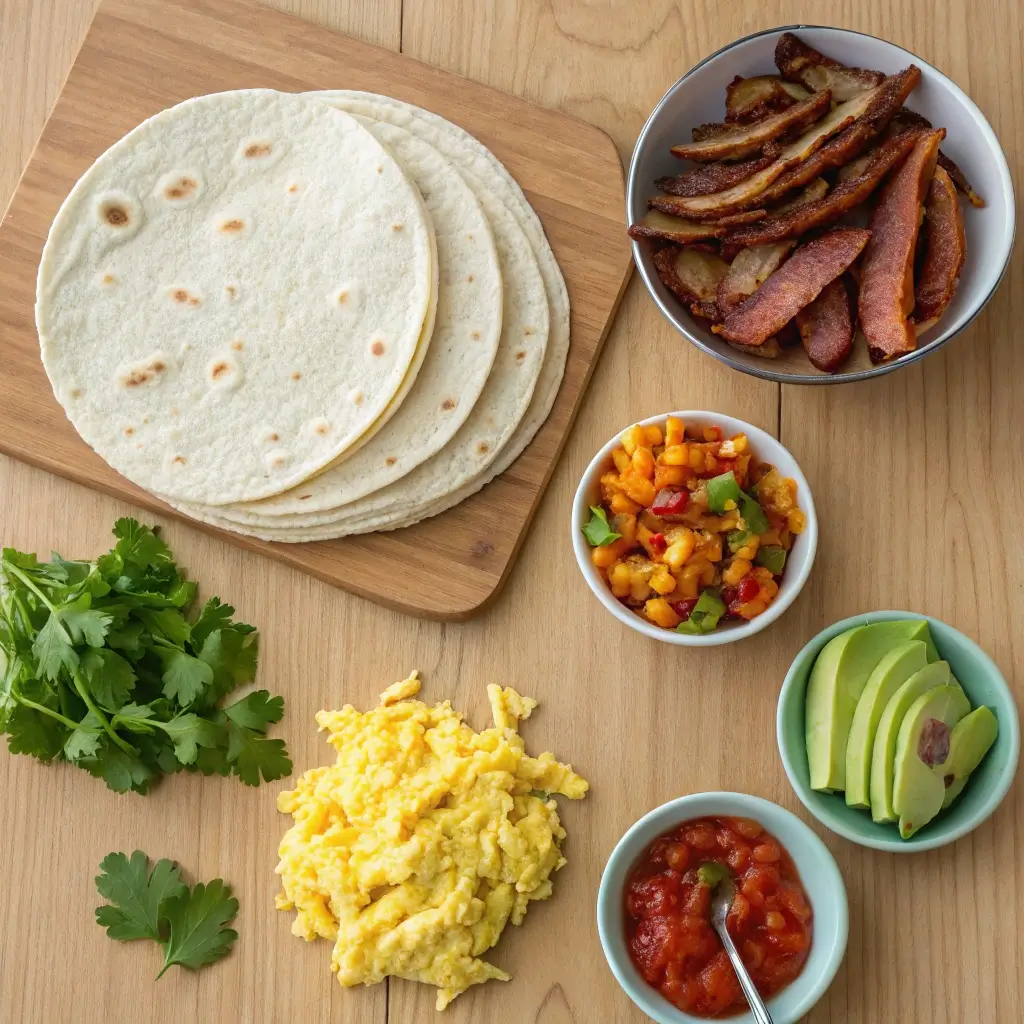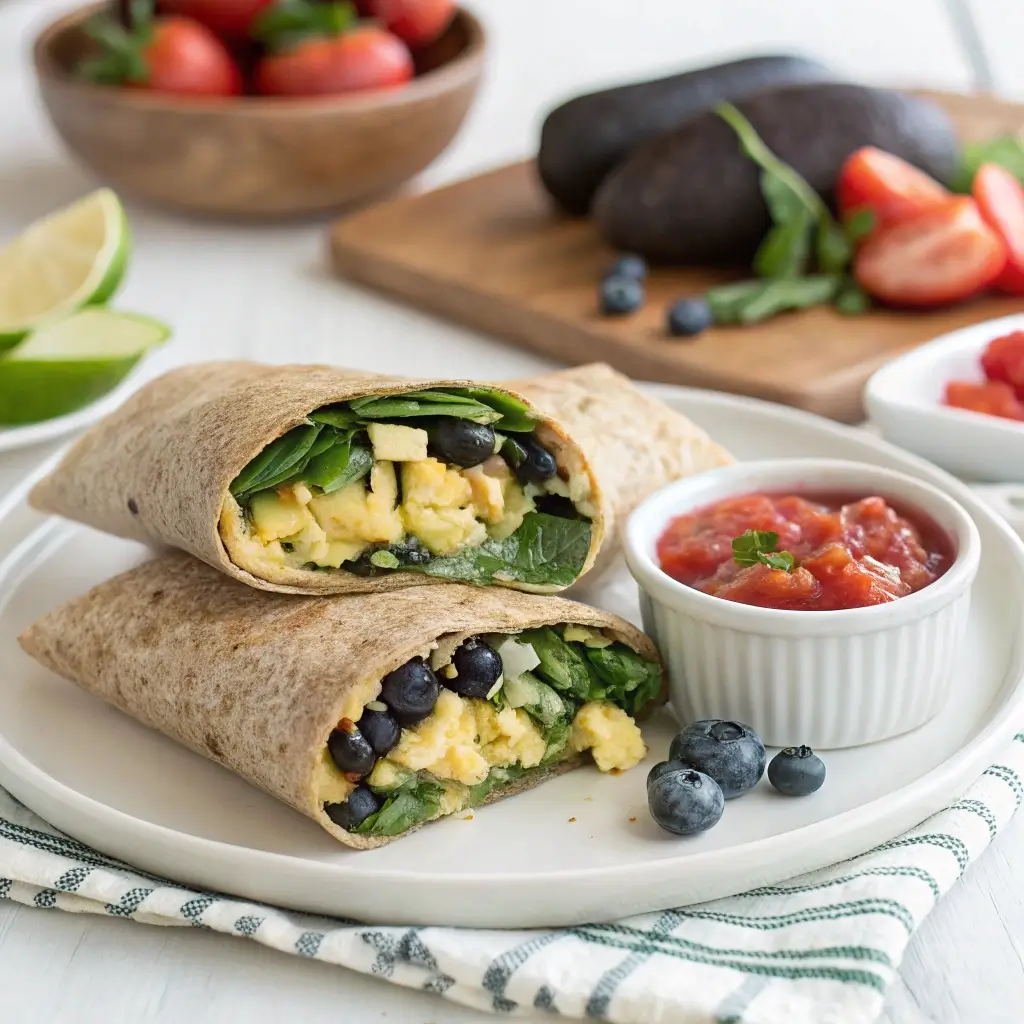
Introduction
Breakfast burritos are a popular morning meal, celebrated for their convenience, versatility, and satisfying flavors. Typically made with a tortilla filled with eggs, cheese, bacon, and other ingredients, they pack a lot of flavor into a portable package.
However, breakfast burritos often raise questions about health. Are they a balanced choice, or do they lean too heavily on high-calorie and high-sodium ingredients? While traditional recipes can be indulgent, breakfast burritos can also be tailored to fit a variety of dietary needs, making them as healthy—or as decadent—as you choose.
The Basic Components of a Breakfast Burrito
At its core, a breakfast burrito contains a few staple ingredients that create its signature taste and texture:
- Eggs: A protein-rich base that adds fluffiness and richness.
- Cheese: Provides creaminess and a savory flavor, but also adds fat and sodium.
- Bacon or Sausage: Offers protein and a smoky, salty taste, but can be high in saturated fat.
- Tortilla: Holds everything together and supplies carbohydrates for energy.
Additional ingredients often include potatoes, beans, vegetables, or sauces, adding variety and additional nutrients. The balance of these components determines the overall healthiness of the burrito.
Nutritional Profile of Breakfast Burritos
Understanding the nutritional value of a breakfast burrito helps clarify its impact on your diet. Here’s a breakdown of a typical serving:
- Calories: 400–700, depending on size and ingredients.
- Protein: 15–25 grams, mainly from eggs, cheese, and meat.
- Fat: 20–40 grams, with significant contributions from cheese and bacon.
- Sodium: 800–1,200 mg, primarily from processed ingredients like bacon and cheese.
While breakfast burritos are a good source of protein and energy, their high fat and sodium content can be a concern. Customizing ingredients is key to improving their nutritional value.
Are Breakfast Burritos Healthy?
Breakfast burritos are a popular choice for many, thanks to their delicious flavors and convenient format. However, their healthiness depends on the ingredients, portion size, and preparation methods. While they offer several nutritional benefits, they also come with potential downsides that are worth considering.
Let’s explore the pros and cons of breakfast burritos to determine if they can be part of a balanced diet.
Health Benefits of Breakfast Burritos
Breakfast burritos can provide a range of health benefits, especially when prepared thoughtfully. Here are some key advantages:
1. Rich in Protein
- Why It’s Beneficial: Eggs, cheese, and meats like bacon or sausage are excellent sources of protein, which supports muscle repair, growth, and sustained energy throughout the day.
- Custom Options: Adding black beans or tofu boosts plant-based protein content, making the burrito more versatile.
2. Packed with Essential Nutrients
- Eggs: Provide vitamins D and B12, as well as choline, which supports brain health.
- Cheese: Offers calcium for strong bones and teeth.
- Vegetables: Ingredients like spinach, peppers, or avocado add fiber, vitamins, and antioxidants.
3. Customization Options
- Breakfast burritos are highly adaptable. You can choose leaner proteins, low-fat cheese, or whole-grain tortillas to improve their nutritional profile.
- Adding vegetables like tomatoes, onions, and leafy greens increases nutrient density and fiber, making the meal more filling and balanced.
With the right ingredients, breakfast burritos can provide a balanced mix of macronutrients (protein, fats, and carbs) and micronutrients, supporting a healthy lifestyle.
Potential Drawbacks of Breakfast Burritos
Despite their benefits, breakfast burritos have potential downsides, especially when made with traditional ingredients or purchased from fast-food chains:
1. High Sodium Content
- The Concern: Processed ingredients like bacon, sausage, and cheese contribute to high sodium levels, with some burritos containing over 1,000 mg of sodium—nearly half the recommended daily limit.
- The Solution: Use low-sodium alternatives like turkey bacon, reduce cheese, or skip heavily salted sauces.
2. High Saturated Fat Levels
- The Concern: Bacon, cheese, and full-fat meats are significant sources of saturated fat, which can raise cholesterol levels if consumed in excess.
- The Solution: Opt for lean proteins like chicken sausage, egg whites, or plant-based alternatives to lower fat content.
3. Calorie Density
- The Concern: A typical breakfast burrito can range from 400 to 700 calories, and oversized portions or added extras (like sour cream or hash browns) can push it even higher.
- The Solution: Control portion sizes and limit high-calorie additions. Smaller tortillas or open-faced burritos can help reduce calorie intake.
4. Fast-Food Pitfalls
- The Concern: Pre-made or fast-food breakfast burritos are often loaded with unhealthy fats, sodium, and preservatives.
- The Solution: Prepare homemade versions to control ingredients and nutritional quality.
Balancing the Pros and Cons
Breakfast burritos can be part of a healthy diet when consumed in moderation and customized to your needs. By choosing wholesome ingredients, balancing portions, and incorporating plenty of vegetables, you can enjoy this popular dish without compromising your nutritional goals.
How to Make a Healthier Breakfast Burrito

Making a healthier breakfast burrito is all about smart ingredient choices and mindful preparation. With a few simple swaps, you can enjoy the delicious flavors of this classic dish while improving its nutritional value.
1. Leaner Proteins
- Swap Bacon for Turkey Bacon or Plant-Based Alternatives: These options are lower in saturated fat and sodium but still provide great flavor.
- Use Egg Whites or Egg Substitutes: Reduces cholesterol and calories while keeping the protein.
2. Lighter Cheese Options
- Opt for Reduced-Fat Cheese: Provides creaminess with less fat.
- Use Nutritional Yeast: A plant-based option that mimics cheesy flavor while adding B vitamins.
3. Healthier Tortillas
- Choose Whole-Grain or Low-Carb Tortillas: These add fiber and reduce simple carbohydrates.
- Try Lettuce or Collard Greens: For a low-calorie, gluten-free wrap.
4. Add Vegetables
- Why It Helps: Vegetables like spinach, bell peppers, onions, and tomatoes increase fiber, vitamins, and antioxidants.
- How to Include: Sauté veggies with a touch of olive oil or add fresh slices of avocado for healthy fats.
5. Limit Sauces and Extras
- Go for Salsa or Hot Sauce: Adds flavor without extra calories.
- Skip Sour Cream: Use Greek yogurt as a creamy, lower-calorie alternative.
By combining these swaps, you can enjoy a satisfying breakfast burrito that aligns with your health goals.
Comparing Homemade vs. Fast Food Burritos
When it comes to nutrition and quality, homemade burritos often outperform their fast-food counterparts. Here’s how they compare:
Homemade Burritos
- Pros:
- Customizable Ingredients: Control the quality and quantity of each ingredient.
- Lower Sodium and Fat: Use fresh, minimally processed items to reduce unhealthy additives.
- Budget-Friendly: Cost-effective when preparing multiple servings.
- Cons:
- Time-Consuming: Requires preparation and cooking time.
Fast Food Burritos
- Pros:
- Convenient: Ready to eat, perfect for busy mornings.
- Standardized Recipes: Consistent flavor and portion sizes.
- Cons:
- High in Calories and Sodium: Often exceeds daily recommended limits.
- Limited Customization: Difficult to adapt to specific dietary needs.
Conclusion: While fast food burritos offer convenience, homemade options provide better control over nutrition and cater to personal preferences.
Breakfast Burritos for Different Diets
Breakfast burritos are versatile and can be adapted to fit a variety of dietary needs. Here are options for common diets:
1. Vegetarian Burrito
- Ingredients: Scrambled eggs, black beans, sautéed veggies, avocado, and shredded cheese.
- Why It Works: Plant-based proteins and fiber-rich beans make it filling and nutritious.
2. Vegan Burrito
- Ingredients: Tofu scramble, black beans, avocado, vegan cheese, and salsa in a gluten-free tortilla.
- Why It Works: Packed with plant-based protein and healthy fats.
3. Gluten-Free Burrito
- Ingredients: Scrambled eggs, turkey sausage, cheese, and veggies wrapped in a gluten-free tortilla or lettuce wrap.
- Why It Works: Offers all the flavor without triggering gluten sensitivities.
4. Low-Carb Burrito
- Ingredients: Egg whites, avocado, grilled chicken, and spinach wrapped in a low-carb tortilla or collard greens.
- Why It Works: High in protein and healthy fats, perfect for keto or low-carb diets.
Each of these options ensures you can enjoy breakfast burritos while meeting your dietary goals.
When Can Breakfast Burritos Be Part of a Healthy Diet?
Breakfast burritos can absolutely be part of a healthy diet when enjoyed thoughtfully. The key lies in balancing portion sizes, ingredient choices, and timing. Here’s how:
1. Portion Control
- Stick to Reasonable Sizes: Large burritos can be calorie-dense, so consider using smaller tortillas or splitting a large burrito into two servings.
- Avoid Overloading Fillings: Focus on nutrient-dense ingredients like eggs, lean proteins, and veggies while limiting high-calorie extras like cheese or heavy sauces.
2. Meal Timing
- Fuel Your Day: Breakfast burritos are an excellent choice in the morning or early afternoon when your body needs energy to stay active.
- Post-Workout Meal: Their combination of protein, carbs, and healthy fats makes them ideal for muscle recovery after a workout.
- Avoid Late-Night Indulgence: Eating a heavy burrito close to bedtime can disrupt digestion and lead to unnecessary calorie consumption.
3. Balance with Other Meals
- If your breakfast burrito is calorie-rich, plan lighter meals later in the day. Include salads, lean proteins, and whole foods to keep your diet balanced.
With proper portioning and mindful timing, breakfast burritos can fit seamlessly into a healthy diet.
Creative and Nutritious Fillings for Breakfast Burritos
The beauty of breakfast burritos lies in their versatility. By swapping traditional ingredients for healthier options, you can create a dish that’s both delicious and nutrient-packed.
1. Vegetables
- Spinach and Kale: Add fiber, vitamins, and minerals without extra calories.
- Bell Peppers and Onions: Provide crunch, flavor, and a dose of antioxidants.
- Sweet Potatoes: A nutrient-rich alternative to hash browns, offering complex carbs and fiber.
- Tomatoes and Avocado: Bring freshness and healthy fats.
2. Lean Proteins
- Egg Whites: Lower in fat and cholesterol, while still high in protein.
- Turkey Bacon or Sausage: Leaner alternatives to traditional pork versions.
- Grilled Chicken or Tofu: Great options for adding variety and extra protein.
- Black Beans or Lentils: Plant-based proteins that are high in fiber.
3. Whole Grains
- Whole-Grain Tortillas: Higher in fiber and nutrients than white flour versions.
- Quinoa or Brown Rice: Add as a filler for additional whole grains and nutrients.
- Farro or Barley: Unique grains that bring texture and a nutty flavor.
4. Flavorful Extras
- Salsa or Hot Sauce: Adds spice and zest without added calories.
- Greek Yogurt: A lower-fat substitute for sour cream.
- Herbs and Spices: Cilantro, cumin, or smoked paprika enhance flavor naturally.
With these creative fillings, your breakfast burrito can become a nutrient-dense powerhouse that’s tailored to your preferences.
FAQs About Breakfast Burritos
Breakfast burritos are a versatile and popular meal, but many people have questions about their preparation, health, and storage. Here are answers to some of the most common questions:
1. How Do I Make a Breakfast Burrito That Doesn’t Fall Apart?
- Use a large, pliable tortilla and avoid overfilling it. Warm the tortilla before assembling, and fold it tightly by tucking in the sides first and then rolling from one end.
2. Can Breakfast Burritos Be Frozen?
- Yes! Wrap each burrito in foil or plastic wrap, then store them in a freezer-safe bag. They can last up to 3 months. To reheat, thaw overnight in the fridge or heat directly from frozen in the microwave or oven.
3. Are Breakfast Burritos Healthy?
- They can be! Homemade burritos with lean proteins, vegetables, whole-grain tortillas, and low-fat cheese can be a nutritious meal. Fast-food versions may be high in calories, sodium, and fat, so enjoy those in moderation.
4. How Long Can a Breakfast Burrito Be Stored in the Fridge?
- Freshly made burritos can be stored in the refrigerator for up to 3 days if wrapped tightly. Reheat thoroughly before eating.
5. What Are Some Quick Additions to Make Them More Nutritious?
- Add spinach, tomatoes, or bell peppers for extra vitamins and fiber. Swap regular bacon for turkey bacon or add black beans for a boost of plant-based protein.
Tips for Enjoying Breakfast Burritos Responsibly
While breakfast burritos are undeniably delicious, it’s essential to enjoy them mindfully to maintain a balanced diet. With a few simple adjustments, you can savor this morning favorite while keeping your nutrition in check.
1. Control Portions for a Balanced Meal
✅ Stick to One Burrito: Since breakfast burritos can be quite filling, limiting yourself to one serving helps prevent overeating. If using large tortillas, consider making smaller versions instead.
✅ Pair with Healthier Sides: Rather than opting for calorie-dense additions like hash browns or extra cheese, balance your meal by adding fresh fruit or a light salad. This way, you get essential fiber and vitamins without unnecessary calories.
2. Customize Ingredients for a Healthier Option
1✔ Choose Whole-Grain or Low-Carb Tortillas: Swapping traditional flour tortillas for whole-wheat or low-carb alternatives adds fiber and keeps you feeling full longer.
2✔ Opt for Lean Proteins: Instead of traditional bacon and sausage, try egg whites, turkey bacon, or grilled chicken for a leaner, protein-packed meal.
3✔ Load Up on Vegetables: Adding spinach, bell peppers, mushrooms, or avocado boosts the nutritional value, providing important vitamins and minerals.
3. Avoid Overindulgence for Long-Term Health
🔸 Limit Heavy Ingredients: While cheese, bacon, and sour cream add richness, they are also high in saturated fats. Reserve these for occasional treats, and opt for lighter versions more frequently.
🔸 Make Homemade Versions: Restaurant and fast-food breakfast burritos often contain excess sodium and preservatives. Instead, making them at home allows you to control the ingredients and portion sizes.
By following these simple guidelines, you can enjoy breakfast burritos guilt-free, making them a regular part of your routine without compromising your health goals.
Breakfast Burritos in Popular Culture
Over the years, breakfast burritos have evolved from a regional favorite into a global phenomenon. Their portability, flavor, and versatility have contributed to their widespread appeal, making them a staple in modern food culture.
1. A Staple of On-the-Go Breakfasts
🚗 Perfect for Busy Lifestyles: Whether you’re heading to work, running errands, or traveling, breakfast burritos offer a quick, filling meal that fits seamlessly into fast-paced routines.
🍽️ A Fast-Food Favorite: Due to their popularity, many fast-food chains and food trucks have adopted breakfast burritos as a menu essential, offering a variety of flavors and combinations.
2. Featured in Media and Pop Culture
🎬 A Comfort Food Icon: Many TV shows and movies depict breakfast burritos as the ultimate comfort food, emphasizing their universal appeal. From late-night cravings to weekend brunch traditions, they’ve become synonymous with indulgence and satisfaction.
📺 Celebrity Endorsements: Several celebrities and chefs have expressed their love for breakfast burritos, further boosting their mainstream status.
3. A Social Media Darling
📸 Instagram-Worthy Appeal: With their colorful layers and customizable fillings, breakfast burritos are a favorite subject for food bloggers. Their aesthetic appeal makes them highly shareable, leading to viral trends on platforms like Instagram, TikTok, and Pinterest.
🔥 Trending Hashtags: Hashtags like #BreakfastBurritoGoals and #BrunchLife highlight their popularity in the digital age, proving that this dish is more than just a meal—it’s a lifestyle statement.
Conclusion
Breakfast burritos are more than just a tasty morning option—they’re a versatile meal that fits into a variety of dietary preferences and lifestyles. Whether you prefer a classic bacon, egg, and cheese burrito or a plant-based version packed with vegetables, the key to making them part of a balanced diet lies in thoughtful preparation and moderation.
Moreover, breakfast burritos have cemented their place in food culture, celebrated for their flavor, convenience, and endless customization possibilities. As they continue to evolve with new trends and innovations, they remain a beloved staple that brings joy to breakfast tables worldwide.
So next time you crave a delicious and satisfying breakfast, consider a breakfast burrito—a timeless classic that offers both taste and nutrition in every bite. 🌯✨
You May also be Interested in:

